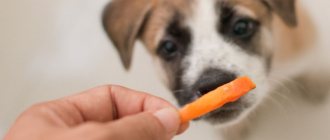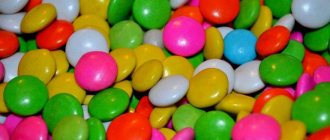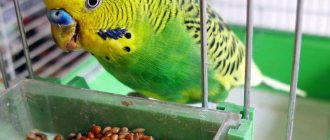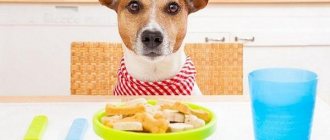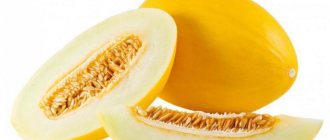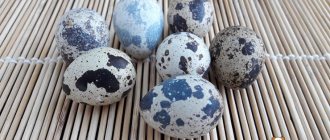Most dog breeders, being adherents of natural feeding for their four-legged pets, fundamentally refuse dry food. Sometimes, for example, in the case of a dog’s illness, experts consider it advisable to switch it to “natural” food.
In this regard, questions about what to feed a dog, which foods must be included in the diet, and which ones should be avoided, become relevant for pet owners. Porridge is one of the most popular dishes, but this does not mean that any cereal can be given to animals.
Buckwheat porridge
According to experts, buckwheat is for animals. It contains vitamins (A, B, E, H, PP), minerals (iron, calcium, zinc, magnesium, etc.), fiber, complex carbohydrates, amino acids.
Buckwheat saturates the body, fills it with vigor and energy.
The value of buckwheat lies in accelerating metabolism, stabilizing the cardiovascular system, strengthening the immune system and bone tissue. Thanks to its unique composition, buckwheat allows the body to rehabilitate faster in the postoperative period. Thanks to it, the dog does not gain weight, and also forgets about what allergies are.
Buckwheat porridge is considered the best option for a pet, but it must be prepared correctly. Here is the method recommended by veterinarians: pour 1 cup of buckwheat into 2 cups of boiling water. Cover the pan with a lid and wrap it in a blanket. Leave overnight. The next morning the porridge is ready to eat. Since most of the beneficial substances are lost during heat treatment, there is no need to cook the dish, nor do you need to add salt and pepper.
Impact
Is it harmful to give to your pet?
Porridge is a thermally processed food of plant origin that a dog would never prepare on its own.
Unlike humans , for whom the main source of energy is glucose, which is a product of the breakdown of carbohydrates, the dog’s body uses ketones - under-oxidized fatty acids.
REFERENCE! The human body also switches to an alternative method of energy supply during periods of carbohydrate deficiency. This process is called ketosis.
Porridges contain large amounts of simple carbohydrates (monosaccharides), which quickly raise blood sugar levels and can cause hyperglycemia .
If a person with type 2 diabetes eats too many carbohydrates at once, they may fall into a hypoglycemic coma.
As for the dog, it won’t fall into someone, but its health will worsen. There will be severe thirst, drowsiness, possible nausea and vomiting, and bloating. This is due to the secretion of insulin. In both dogs and diabetic people, its amount is reduced. The pancreas is not designed for large amounts of carbohydrates, which causes problems with the intake of carbohydrates.
Benefits for humans
But as for healthy people, porridge supplies the body with energy, fiber, microelements, vitamins (calcium, fluorine, magnesium, sodium), and helps improve digestion. Why is there such a big difference? Because humans have been consuming carbohydrates for quite a long time, although primitive people ate exclusively eggs and animal meat.
REFERENCE! Excessive consumption of carbohydrates leads to atherosclerosis, obesity, increased hematocrit (thickness) of blood, diabetes mellitus, metabolic disorders, and hormonal imbalances. We are talking not only about “simple”, but also about “complex” carbohydrates.
Just like dogs, humans began to eat plant components in the process of evolution in order to be able to survive . With the development of the food industry and the emergence of a large assortment of cereals and flour products, the problem of obesity has become acute.
Atherosclerosis, diabetes mellitus, diseases of the cardiovascular system, all this appeared not so long ago . Literally 200 years ago, people did not suffer from such ailments and lived much longer.
Consequences
Porridge shifts the natural pH level to the acidic side, which can cause dysbiosis. In this state, all food is digested worse, some elements of the diet are perceived as foreign, poisoning, vomiting, and constipation are possible.
In some cases, the dog’s body will be able to digest porridge, sugar, and even bread made from white flour. After prolonged hunger or intense exercise, you can give your pet carbohydrates. It's all about low blood sugar levels, which take a long time to recover on their own.
If you ate too much
The first sign of intoxication will be thirst. The pet will drink without interruption, the tongue will hang to one side, breathing will become faster, body temperature will drop, and there may be an odor of acetone.
First aid for poisoning:
- You need to give the dog a solution to induce vomiting (soda and salt, in a 1:1 ratio, diluted in a glass of warm water).
- Take the animal to fresh air.
- Call a doctor.
- Give your pet an absorbent (activated carbon, etc.).
- An hour after this, you can take a laxative.
Rice porridge
Rice is enriched with vitamins B, E, magnesium, calcium, zinc, iron, copper and other minerals, lipids. Cereals are a natural antioxidant and adsorbent and cleanse the body of toxins. That is why it is recommended for dogs that have previously been diagnosed with poisoning. In addition, it is endowed with astringent properties, so it is useful for animals with diarrhea.
Rice porridge gently envelops the stomach and reduces pain, so pets suffering from inflammatory processes in the digestive tract should definitely eat this dish.
However, rice also has contraindications. Due to its high starch content, it can be harmful to dogs with diabetes, obesity, and diarrhea. This does not mean that rice porridge is prohibited for such patients, it just needs to be given occasionally, to diversify the diet.
Preference should be given to unpolished rice, since it contains less starch than polished rice and more vegetable protein.
Method of preparation: rinse the cereal, soak it for an hour and a half in cold water. Soaking unpolished rice - 20 minutes. Boil. If the porridge turns out to be thick, you can add a little vegetable oil.
Oats
Oats and rolled oats should not be confused. Oats are whole grains, while rolled oats are flattened grains. However, both cereals are very useful for your pet. They contain vitamins A, B, E, PP, minerals (calcium, potassium, magnesium, sodium, etc.), vegetable proteins, amino acids, fats.
Diet porridge is an indispensable product for normalizing digestion after an illness accompanied by vomiting and diarrhea, or prolonged fasting. Gluten delicately envelops the intestines and walls of the digestive tract, and has a beneficial effect on the stomach and pancreas during inflammation. Oatmeal and jelly are always recommended by nutritionists for animals with gastritis and enteritis.
Do not forget: oatmeal can cause allergies and digestive upset. If you are giving oatmeal for the first time, add it in small quantities to the main dish to check whether it will become an allergen for your pet, and observe for a day. If your dog does not have an allergic reaction to oatmeal, include it in the diet, but do not overuse it.
It is advisable to give preference to oats other than oatmeal. It takes longer to cook, but it contains more nutrients. To prepare the grains, soak them in cold water for 2-3 hours, then boil them without adding salt. With soaking, the cereal will cook in 40-50 minutes.
The benefits of fiber
For a full life, dogs need complex carbohydrates (fiber) , a completely different type, those found in vegetables and bran and not absorbed by the animal’s body. It is complex carbohydrates that create healthy microflora in the dog’s intestines.
Although fiber is practically not absorbed by the body, it is simply necessary for the normal functioning of the gastrointestinal tract . Fiber ensures the movement of food through the gastrointestinal tract and the excretion of feces. In addition, it controls blood sugar levels.
Corn porridge in no way should be the main part of the diet, but occasionally, as a supplement and in small quantities (maximum 20% of the total serving), they can still be given to a dog, there will be no particular harm. When the corn content in porridge increases, there can be no question of normal microflora in the intestines.
Semolina
Semolina, like millet, is an absolutely useless product for dogs. Semolina contains no useful substances, but a lot of simple carbohydrates.
However, the doctor may recommend it to premature newborn puppies to gain weight or to animals with gastrointestinal inflammation (for the period of treatment, so as not to burden the stomach and intestines).
Semolina is contraindicated for dogs that are overweight, prone to obesity, sedentary individuals and animals with diabetes (cereals contribute to an increase in blood sugar levels).
In what form can it be given?
Corn will not bring any benefit to the dog; small amounts can only be given to diversify the diet. At the same time, in order not to harm the pet, it is important to choose the right form of the product. Can dogs eat corn grits, cobs, or canned food?
Raw
Giving your dog corn on the cob is dangerous. Undoubtedly, your pet will enjoy gnawing on sweet grains, but after entering the stomach, they will sharply increase in volume. Such particles will not be completely digested and will pass down the intestines unchanged. The consequence of this is constipation, and intestinal volvulus is possible. Pathology leads to a long and painful death.
It is easy to choke on the cob, so it is better not to give it to even large pets.
Canned
In cans, cereal is sold in the form of individual grains, it is difficult to choke on them, and it is easy to control the portion size. Can dogs eat canned corn?
The answer is negative, since in addition to the potential harm from the product itself, there is a burden on the stomach in the form of sugar, vinegar and other spices included in the preservative.
Boiled
The cob can be boiled or baked in the oven. The cooked product is safer than the raw product, as it is easier to digest, but it will not be beneficial for the animal. Minerals and vitamins will not be absorbed, and the load on the stomach will remain significant.
As a component of dry food
Corn starch is often used as a component of industrial feed. It is added to inexpensive brands to increase the nutritional value of the product, but constant consumption of such food leads to:
- increased blood sugar levels;
- increased insulin levels;
- as a result, diabetes and obesity.
Barley porridge
Despite the fact that this cereal is very nutritious and enriched with vitamins, micro- and macroelements (fluorine, silicon), it is not suitable for daily use. The fact is that it is poorly absorbed by the body. Nevertheless, it must be given. For it to really bring benefits, it is better to mix it with other porridges, for example, with buckwheat.
Tip: feed your pet only freshly cooked porridge, after cooling it to room temperature. A cold dish turns into an unappetizing mess and is not absorbed by the body.
If the dog ate corn porridge
And the animal’s diet should contain complex carbohydrates, which are part of bran or vegetables. Thanks to such elements, beneficial microflora develops in the intestines.
Despite the fact that fiber is practically not digestible, it is necessary for the normal functioning of the digestive system.
This component improves intestinal motility, preventing constipation.
Corn porridge should not form the basis of a dog's daily diet. It can sometimes be added in small quantities to the main food (no more than 20% of the total serving).
If a dog has eaten a little corn porridge, then such a portion will not pose a threat to the body . It is worth remembering that excessive consumption of the product can provoke tympany - this is a condition in which bloating occurs.
Signs indicating a problem will be the following:
- sickly appearance of a four-legged pet;
- depressed state;
- breathing problems;
- excessive abdominal enlargement;
- lethargy and apathy.
Expert opinion
Makarenko Svetlana Igorevna
Practicing veterinarian, 15 years of experience.
When you tap the affected area, you may hear a dull sound. In this case, actions are taken to alleviate the animal’s condition. You need to do a stomach massage. In order for the gases to come out faster, you need to make the dog move.
If the situation worsens, it is necessary to puncture the stomach to relieve it of gases. The procedure is performed by a specialist.
Corn porridge
Regarding whether it is possible to give a dog corn porridge, veterinarians agree: no, it is not! Just like millet and semolina, corn is completely useless for animals. Undoubtedly, it quenches the appetite well and gives a feeling of satiety, but it does not provide any nutritional value. But it's not only that.
Porridge passes through the gastrointestinal tract very difficultly, forms clumps and is poorly digested. In dogs that lead an active lifestyle, it can cause volvulus, a dangerous pathology. Under no circumstances should you give corn porridge to animals experiencing digestive problems, otherwise exacerbations cannot be avoided.
It is much more useful to offer the dog to chew on a fresh corn cob, but you need to make sure that he does not get carried away and get to the core. Don't be alarmed if the grains come out undigested in your feces.
What risks are present?
As already noted, there are practically no contraindications for this product. Here it is worth talking only about individual intolerance. We are all unique and individual, and so are dogs. In extremely rare cases, individual intolerance is possible. But this will become clear literally at the first feeding. By the way, the first time you can give your dog rice only in a very small amount, as they say, a pinch. If everything goes well, then you don’t have to worry anymore.
Separately, it is necessary to note white polished rice. Nutritionists do not really approve of this product even for people, and veterinarians prohibit it for pets. What's the problem?
- It is much less digestible. Dogs have rather short intestines, and as a result, the product can cause constipation, even with minor overeating. In addition, it will simply be excreted naturally. And the pet simply will not receive the nutritional components that we are counting on.
- High starch content is also not beneficial. It contributes to obesity, constipation, and just heaviness in the stomach.
- Starch is ultimately sugar, which is extremely harmful, even in small quantities.
What to add to porridge
As mentioned above, salt and spices should not be added to porridge. And excess fats will not be beneficial for your pet. However, you won’t be satisfied with porridge alone, so add meat and vegetables to it.
Vegetables are rich in fiber, which is beneficial for intestinal motility. Carrots, beets, rutabaga, pumpkin, and zucchini are most suitable for this purpose. You can give broccoli, cauliflower, and potatoes with caution. But you can’t give onions and garlic.
As for meat, the ideal option is turkey and rabbit, veal, horse meat. These are lean meats that will not harm the liver and are hypoallergenic.
Pork and lamb are too fatty, so they should be excluded from the menu.
Chicken is a dietary product, but it can cause allergies. Meat products must be subjected to heat treatment; frozen meat is also allowed.
By-products are very useful. The liver is a source of vitamins and micro- and macroelements; the heart, rumen, and lungs are good in this regard. They should be included in the diet boiled, as offal can be contaminated with helminths.


